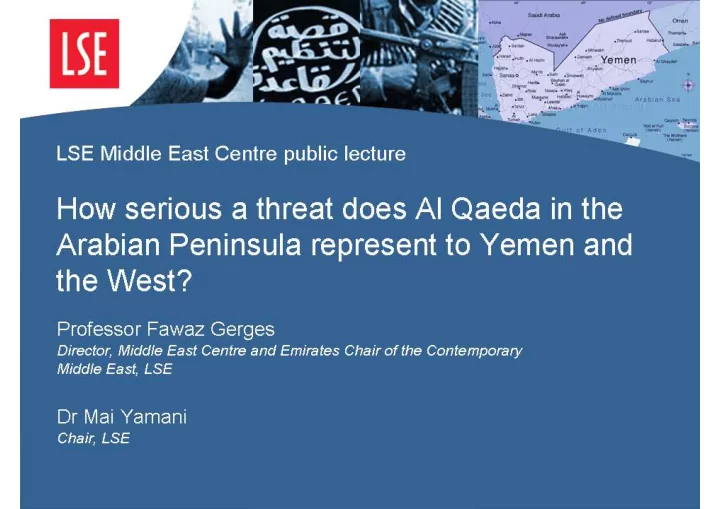

How serious a threat does Al Qaeda in the Arabian Peninsula represent to Yemen and the West? “Yemen is a troubled state, but no Afghanistan,” argues Professor Fawaz Gerges .
Yemen’s worrying reality Statistics do not convey the extent of social and economic misery in Yemen: • Almost 40% of the country’s 23 million people are unemployed. • More than a third of the population is undernourished. • Almost 50% live in absolute poverty. • One of the highest fertility rates in the region— upwards of 3.7% . • 60% of the population is under the age of 20 . A problem in this regard is that, while the population has increased at a very high pace, resources have declined at an even faster rate: • In the next few years, Yemen’s oil—its major source of hard currency—will only meet the country’s domestic consumption needs. • Moreover, the WHO has warned that by 2025 Yemen will be facing severe water shortages.
1989 – The End of the Afghan War
1990 -1991 the Gulf War - A Disaster for Yemen • A million migrants expelled from Saudi Arabia and the peninsula back to Yemen. • The beginnings of a grave prolonged social and economic crisis. • Below – Yemeni refugee migrant workers.
The Yemen Civil War - 1994 • Jihadis join the Saleh Government in the fight against the socialist South and forcefully unify the North and South. • Jihadis play a key role in the New Union. • The Yemeni Contingent Is one of the biggest within Bin Laden's al-Qa`ida.
9/11 and the splintering of the Jihadis The Saleh Government tries to co-opt Jihadis. Bottom Photo - Ali Abdullah Saleh Right Photo – Twin Towers, 11 th September 2001 - NY
The Revival of the Yemen Al Qaeda Branch The Yemen branch – led by a former private secretary to • Bin Laden, Nasser al-Wahishi (Top Photo) , disciplined and experienced, and its military commander Qassim al- Raymi (Bottom Photo) - has become more organized and coherent; its recent resurgence is closely linked to deteriorating social, economic, and political conditions in this poorest Arab country, as well as the dismantling of its neighbouring Saudi group. The structure and conduct of the Yemen branch has • changed since the 2009 merger between the Saudi and Yemeni branches into a single unit called al-Qa`ida in the Arabian Peninsula. The arrival of approximately 50- 300 fighters (most of whom are rookies with the exception of two dozen seasoned and skilled fighters) from Saudi Arabia, fleeing a lost cause there, some of whom had fought in Iraq and Afghanistan, has revitalized a previously chaotic Yemen branch and has provided leadership, motivation, operational know-how like bomb- making, and a sense of purpose, direction, and daring.
Ibrahim Hassan al-Asiri Saudi operator of AQAP, Ibrahim Hassan al-Asiri (Photo) , 28, who studied chemistry at King Saud University, is believed to be the top technical expert and bomb-makers. American intelligence officials assert that the young Saudi designed the foiled mail bombing in October 2010, as well as the underwear explosives that failed to detonate abroad a Detroit-bounder airliner in Dec. 2009.
Anwar al-Awlaki AQAP members can now study ideology and theology from Anwar al- Awlaki (Photo) – the Yemeni-American cleric the Obama administration designated in April 2010 as a legitimate target for assassination – who provides them with theological guidance and legitimation.
AQAP today • What al-Qa`ida in the Arabian Peninsula has tried to do is to submerge and embed itself in these raging local conflicts - particularly in the south, mainly in the Shabwah and adjacent Abyan provinces and the Marib province, east of Yemen’s capital. Al-Qa`ida (AQAP) has found a fertile ground in the south because it is filled with unemployed and poor young men who are angry at the government’s broken promises.
A Map showing the three provinces: Abyan, Marib and Shabwah. Khaled Abdul Nabi (Top Photo) Khaled Abdul Nabi is considered the leader of the Abyan Aden Islamic Army, one of many groups operating in Yemen
Recommend
More recommend